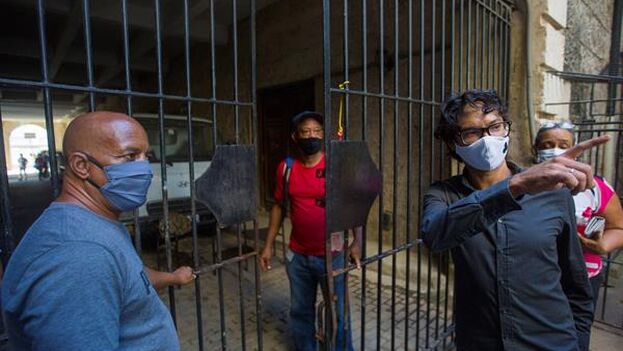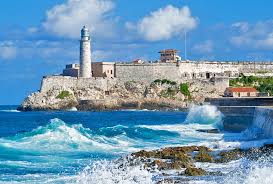(OPINION) CUBA, EL FIN DE LA FIESTA, AL DOBLAR LA ESQUINA
Es prácticamente imposible impedir los cambios hacia la apertura en la Isla. Silvio Rodríguez le ha dado una lección a Miguel Díaz-Canel sobre cómo tratar a la oposición en su reunión con Yunior García y su esposa Dayana.

Yunior García, uno de los líderes de Archipiélago, en el momento en que recibió la respuesta oficial que declaraba “ilícita” la marcha del 15N. (EFE)
LA MARCHA CUBANA DEL 15 DE NOVIEMBRE ha sido convocada por Archipiélago. Esa agrupación no es un partido político y no pretende sustituir a los comunistas en la dirección del país. Toma su nombre de la diversidad. No es cierto que Cuba sólo sea una Isla. Es una isla grande –mayor que Holanda y Bélgica combinadas– y son muchos islotes habitables, a los que se agregan Isla de Pinos y la abundante cayería.
Tampoco sus integrantes están al servicio de los “americanos” o, concretamente, de la CIA. Esa es la clásica infamia con la que el régimen pretende descalificar a los que se oponen a su forzada unanimidad. Los numerosos miembros y simpatizantes de Archipiélago lo que desean es manifestarse y decir sus verdades amparados en la Constitución.
La Constitución garantiza la libertad de pensamiento, pero, simultáneamente, condiciona lo que se lo que se dice a los fines socialistas diseñados por el orden institucional del propio texto. Es deliberadamente ambiguo, dado que el modelo es la Constitución de Stalin de 1936 y sus derivados. Por una punta establece los derechos fundamentales. Por la otra, los suprime.
Son millares los cuadros del propio Partido Comunista que se autodenominan “reformistas” y están deseosos de iniciar un cambio sustantivo que les permita abandonar para siempre las supersticiones colectivistas
En el caso cubano, cuando Oswaldo Payá Sardiñas, en nombre del Movimiento Cristiano de Liberación, presentó las más de diez mil firmas (recabó más de 14.000) que se requerían para someter a referéndum una enmienda constitucional que autorizaría el multipartidismo, el Parlamento cubano (la Asamblea Nacional del Poder Popular) no se dignó a responderle.
En 2012, sencillamente, lo asesinaron junto a Harold Cepero. Molestaban demasiado. Lo cuenta Human Rights Watch: tras un confuso incidente, en el que sólo murieron los cubanos, pese a que ambos habían salido por sus propios pies del auto. Esto lo dijo Ángel Carromero, un joven español que conducía el coche el día del crimen.
Previamente, la Constitución, los fines comunistas de la sociedad cubana y el rol del Partido habían sido “blindados” de manera que resultara muy improbable modificar el curso de los acontecimientos cubanos. No obstante, es prácticamente imposible impedir esos cambios hacia la apertura. ¿Cuándo sucederán? Una vez que exista una masa crítica que los demande o, en su defecto, cuando exista la voluntad política de efectuarlos por cierta gente con poder efectivo.
En Cuba concurren ambas fuerzas. El 11 de julio pasado se hizo patente que los jóvenes desean ampliar los márgenes de participación de la sociedad, pero, al mismo tiempo, son millares los cuadros del propio Partido Comunista que se autodenominan “reformistas”, y están deseosos de iniciar un cambio sustantivo que les permita abandonar para siempre las supersticiones colectivistas y autoritarias. Son 62 años de fracasos continuados.
LOS CASOS DE BROUWER, MILANES Y SILVIO RODRIGUEZ.
En ese sentido, los casos de Leo Brouwer, Pablo Milanés y Silvio Rodríguez, aunque diferentes, son muy significativos. Repitieron el “hasta aquí hemos llegado” de José Saramago cuando en La Habana fusilaron a tres jóvenes negros el 11 de abril de 2003. Brouwer se distanció tajantemente del régimen cubano por la represión ejercida contra la sociedad civil el 11 de julio de este año. Golpearon y encarcelaron a centenares de personas pacíficas, lo que a este sobrino nieto de Ernesto Lecuona, gran guitarrista y gran compositor, le resultaba intolerable.
Silvio Rodríguez le ha dado una lección a Miguel Díaz-Canel sobre cómo tratar a la oposición. Pero ha recibido otra lección bastante obvia: ha escuchado que Yunior y Dayana “no se sienten parte del proceso cubano”
Pablo Milanés vive en España desde 1992, de manera que no es de extrañar su franca ruptura con el régimen, expresada en circunstancias anteriores y ahora reiterada.
Más significativa fue la posición adoptada por Silvio Rodríguez. Se reunió más de una hora con el joven dramaturgo Yunior García Aguilera tras su arbitraria detención, animador de Archipiélago, y con su mujer, Dayana, realizadora de cine. De esa reunión salió una petición formal del cantautor a la dictadura para que pusiera en libertad a los cientos de detenidos que no hubieran ejercido la violencia.
Dijo Silvio Rodríguez en Facebook: “El encuentro con Yunior y Dayana fue bueno, no exagero si digo que fraterno; hubo diálogo, intercambio, nos escuchamos con atención y respeto. Para mí lo más doloroso fue escuchar que ellos, como generación, no se sentían ya parte del proceso cubano sino otra cosa. Me explicaron sus argumentos, sus frustraciones. Traté de hacerles comprender que a mis años también todo resultaba mucho más lento de lo que esperábamos que fuera”.
Silvio Rodríguez le ha dado una lección a Miguel Díaz-Canel sobre cómo tratar a la oposición. Pero ha recibido otra lección bastante obvia: ha escuchado que Yunior y Dayana “no se sienten parte del proceso cubano”.
Es tan antiguo el cuento de la Sierra Maestra que no es posible, para los muchachos jóvenes, vincularse emocionalmente a esas historietas. Silvio nació en los años cuarenta. Yunior en los ochenta. Si Silvio fuera tan racional como aparenta le diría a Díaz-Canel que se preparara para el fin de la fiesta. Está al doblar de la esquina.
(OPINION) CUBA, THE END OF THE FIESTA IS AROUND THE CORNER
It is practically impossible to prevent changes towards openness on the island. Silvio Rodríguez has taught Miguel Díaz-Canel a lesson on how to deal with the opposition in his meeting with Yunior Garcia and his wife Dayana.

Yunior García, one of the leaders of the Archipelago, at the time he received the official response declaring the march of 15N “illegal”. (EFE)
THE CUBAN MARCH ON NOVEMBER 15 has been called by Archipelago. This group is not a political party and does not intend to replace the communists in the leadership of the country. It takes its name from diversity. It is not true that Cuba is only one island. It is a large island – larger than the Netherlands and Belgium combined – and there are many habitable islets, to which are added the Isle of Pines and the abundant keys.
Nor are its members at the service of the “Americans” or, specifically, of the CIA. This is the classic infamy with which the regime tries to disqualify those who oppose its enforced unanimity. What the many members and supporters of the Archipelago want is to express themselves and tell their truths under the Constitution.
The Constitution guarantees freedom of thought, but, simultaneously, conditions what is said to the socialist ends designed by the institutional order of the text itself. It is deliberately ambiguous since the model is Stalin’s 1936 Constitution and its derivatives. For one point it establishes the fundamental rights. On the other, it suppresses them.
There are thousands of cadres from the Communist Party itself who call themselves “reformists” and are eager to initiate a substantive change that will allow them to abandon collectivist superstitions forever.
In the Cuban case, when Oswaldo Payá Sardiñas, on behalf of the Christian Liberation Movement, presented the more than 10,000 signatures (collected more than 14,000) that were required to submit a constitutional amendment to a referendum that would authorize the multiparty system, the Cuban Parliament ( the National Assembly of People’s Power) did not deign to answer him.
In 2012, he was simply murdered along with Harold Cepero. They bothered me too much. Human Rights Watch tells it: after a confusing incident, in which only the Cubans died, despite the fact that both had left the car by their own feet. This was said by Ángel Carromero, a young Spanish man who was driving the car on the day of the crime.
Previously, the Constitution, the communist aims of Cuban society, and the role of the Party had been “shielded” in such a way that it was highly unlikely to modify the course of Cuban events. However, it is practically impossible to prevent such changes towards openness. When will they happen? Once there is a critical mass that demands them or, failing that when there is the political will to carry them out by certain people with effective power.
Both forces concur in Cuba. On July 11, it became clear that young people want to expand the participation margins of society, but, at the same time, there are thousands of cadres from the Communist Party itself who call themselves “reformists”, and are eager to initiate a substantive change that allows them to abandon collectivist and authoritarian superstitions forever. They are 62 years of continuous failures.
THE CASES OF BROUWER, MILANÉS AND SILVIO RODRÍGUEZ.
In this sense, the cases of Leo Brouwer, Pablo Milanés, and Silvio Rodríguez, although different, are very significant. They repeated José Saramago’s “this far we have come” when they shot three young black men in Havana on April 11, 2003. Brouwer sharply distanced himself from the Cuban regime for the repression exercised against civil society on July 11 of this year. Hundreds of peaceful people were beaten and imprisoned, which was intolerable to this great-nephew of Ernesto Lecuona, a great guitarist, and a great composer.
Silvio Rodríguez has taught Miguel Díaz-Canel a lesson on how to deal with the opposition. But he has received another quite obvious lesson: he has heard that Yunior and Dayana “do not feel part of the Cuban process.”
Pablo Milanés has lived in Spain since 1992, so his frank break with the regime, expressed in previous circumstances and now reiterated, is not surprising.
More significant was the position taken by Silvio Rodríguez. He met for more than an hour with the young playwright Yunior García Aguilera after the arbitrary arrest of him, an animator from the Archipelago, and with his wife, Dayana, a filmmaker. From that meeting came a formal request from the singer-songwriter to the dictatorship to release the hundreds of detainees who had not exercised violence.
Silvio Rodríguez said on Facebook: “The meeting with Yunior and Dayana was good, I am not exaggerating if I say fraternal; there was dialogue, exchange, we listened to each other with attention and respect. For me, the most painful thing was hearing that they, as a generation, did not know they already felt part of the Cuban process but something else. They explained their arguments, their frustrations to me. I tried to make them understand that at my age, everything was much slower than we expected it to be. ”
Silvio Rodríguez has taught Miguel Díaz-Canel a lesson on how to deal with the opposition. But he has received another quite obvious lesson: he has heard that Yunior and Dayana “do not feel part of the Cuban process.”
The story of the Sierra Maestra is so old that it is not possible for young boys to bond emotionally with these stories. Silvio was born in the 1940s. Yunior in the eighties. If Silvio were as rational as he appears he would tell Díaz-Canel to get ready for the end of the party. It is around the corner.
Agencies/ Carlos Alberto Montaner/ Internet Photos/ Arnoldo Varona/ www.TheCubanHistory.com
THE CUBAN HISTORY, HOLLYWOOD.



 (OPINIÒN) Cuba, el Fin de la Fiesta, al doblar la Esquina. PHOTOS. * (OPINION) Cuba, the End of the Fiesta is Around the Corner. PHOTOS.
(OPINIÒN) Cuba, el Fin de la Fiesta, al doblar la Esquina. PHOTOS. * (OPINION) Cuba, the End of the Fiesta is Around the Corner. PHOTOS.




